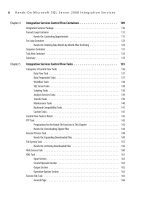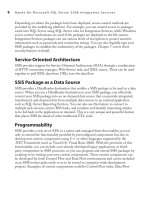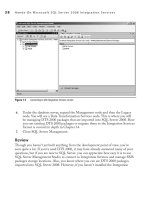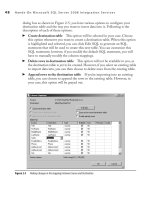Hands-On Microsoft SQL Server 2008 Integration Services part 8 doc
Bạn đang xem bản rút gọn của tài liệu. Xem và tải ngay bản đầy đủ của tài liệu tại đây (524.03 KB, 10 trang )
48 Hands-On Microsoft SQL Server 2008 Integration Services
dialog box as shown in Figure 2-5, you have various options to configure your
destination table and the way you want to insert data into it. Following is the
description of each of these options:
Create destination table
c is option will be selected in your case. Choose
this option whenever you want to create a destination table. When this option
is highlighted and selected, you can click Edit SQL to generate an SQL
statement that will be used to create this new table. You can customize this
SQL statement; however, if you modify the default SQL statement, you will
have to manually modify the column mappings.
Delete rows in destination table
c is option will not be available to you, as
the destination table is yet to be created. However, if you select an existing table
to import data into, you can then choose to delete rows from the existing table.
Append rows to the destination table
c If you’re importing into an existing
table, you can choose to append the rows to the existing table. However, in
your case, this option will be grayed out.
Figure 2-5 Making changes in the mappings between Source and Destination
Chapter 2: Getting Started with Wizards 49
Drop and re-create destination table c is check box option allows you to
delete an existing table and then re-create and load data into it.
Enable identity insert
c You will be using this option if you want to keep the
identity in the input data and want to insert it into the destination table.
9. Let’s change a mapping in the Mappings section to see how it works. Click in
the Suffix destination column and then the drop-down box to select <Ignore>,
as shown in Figure 2-5.
Now click Edit SQL, and note that the SQL statement for creating the destination
table has picked up the change you just made. You can make changes to the
SQL statement or use already existing scripts to create a table. However, once
you have modified the SQL statement, any subsequent changes made from
the Mappings section will not be automatically picked up by the SQL, but must
be manually edited. First click Cancel and then click OK to return to the Select
Source Tables And Views window. Click Next to move on to the Save And Run
Package dialog box.
10. By default, the Run Immediately option will be selected. Check the Save SSIS
Package option to save this package, and then select the File System radio button.
Click the drop-down arrow in the Package Protection Level dialog box to see
the available options. Integration Services protects your package according to the
protection level you select for your package. You will study these options in detail
in Chapter 7; however, brief descriptions of these options are provided here for
your quick review:
Do
c not save sensitive data Using this option, you choose not to save
sensitive information such as connection strings, passwords, and so on within
the package.
Encrypt sensitive data with user key
c is is the default option that can
save sensitive information within the package after encrypting it using a key
that is based on the user who creates and saves the package. With this option
selected, only the user who creates the package will be able to run the package
without providing the sensitive information. If other users try to load the
package, the sensitive information is replaced with blank data and the package
will fail to run unless they provide the sensitive information manually.
Encrypt sensitive data with password
c With this option, you choose to save
the sensitive information in the package after encrypting it with a password.
Once the package is encrypted with this option, any user will be able to open
and execute the package by providing the password. If the user is unable to
provide the password, he or she will have to provide the sensitive information
manually to run the package.
50 Hands-On Microsoft SQL Server 2008 Integration Services
Encrypt all data with user key c Selecting this option means that all the
information and metadata in the package will be encrypted using a key that
is based on the user who is creating the package. Once the package has been
encrypted using this option, only the user who created the package can open
and run it.
Encrypt all data with password
c With this option, you can encrypt all the
information and the metadata in the package by providing a password. Once
the package has been encrypted with this option, it can be opened and run
only after providing the password.
If you choose to save the SSIS package into SQL Server, you will see one additional
option in the Package protection level:
Rely on server storage and roles for access control
c When you save your
packages to the MSDB database of an SQL Server, Integration Services
provides additional security features that allow you to secure packages based
on the three fixed database-level roles: db_ssisadmin, db_ssisltduser, and
db_ssisoperator. You will study more about these roles and the ways to use
them to control access to your packages in Chapter 7.
11. Select the Encrypt sensitive data with password option and type 12wsXZaq in the
Password and Retype Password fields and click OK.
12. Type Importing RawDataTxt in the Name field and Importing comma
delimited RawDataTxt file in the Description field. Type C:\SSIS\Packages\
Importing RawDataTxt in the File Name field, as shown in Figure 2-6.
13. Click Next to open the Complete The Wizard screen. Here you have the option
of reviewing the choices you have made. Once you are happy with them, click
Finish.
The wizard now runs the package created, imports all the records, and shows
a comprehensive report for all the intermediary steps it processed, as shown in
Figure 2-7. This window not only shows any messages or errors appearing at run
time but also suggests some of the performance enhancements that can be applied
to your SSIS packages.
You can see the detailed report by clicking Report and selecting View Report.
You can also save the report to a file, copy it to the Clipboard, or send it as an
e-mail using the Report button.
14. Click Report and choose View Report. Scroll down to the Validating section to
read that SQL Server Import and Export Wizard suggests removing the Suffix
column from the source selections to improve the performance of execution, as
this is not used in the Data Flow task. The data is handled in the memory buffers
Chapter 2: Getting Started with Wizards 51
as it flows through the data flow or the pipeline. More columns mean that fewer
rows can be accommodated in a memory buffer. So, removing unused columns
will save memory space and allows more rows to be accommodated in a buffer,
making the data flow task more efficient. It is always worth taking a quick look at
this report, which may offer valuable comments about the package performance.
Close all the windows.
15. Start Windows Explorer and navigate to the C:\SSIS\Package folder. You will
see a file called Importing RawDataTxt.dtsx saved in this folder. This is the
Integration Services package saved in the XML format with an extension of .dtsx.
Right-click this file, choose Open With, and then choose Notepad from the list
of programs. You will see that the package settings listed in this file are in XML
format. Close Notepad without making any changes.
Figure 2-6 Saving SSIS package to the file system
52 Hands-On Microsoft SQL Server 2008 Integration Services
16. Choose Start | All Programs | Microsoft SQL Server 2008, and click SQL Server
Management Studio to start the program.
17. When the SQL Server Management Studio starts, you will be asked to provide
authentication and connection details in the Connect To Server dialog box.
In the Server Type field, select Database Engine. You can connect to various
services such as Analysis Services, Integration Services, Reporting Services, and
SQL Server Compact Edition by selecting an option from the drop-down menu.
Specify the server name or simply type localhost to connect to the local server in
the Server name field. In the Authentication field, leave Windows Authentication
selected and click Connect to connect to the SQL Server 2008 database engine.
18. When the SQL Server Management Studio loads, in the Object Explorer on the
left, expand the Databases node. Note that the Campaign Database is also listed
in the list of databases. Expand the Campaign Database node and then Tables
Figure 2-7 Checking the execution results
Chapter 2: Getting Started with Wizards 53
node by clicking the plus sign next to them. You will see the dbo.RawDataTxt
table listed there.
19. Click New Query on the menu bar of Management Studio to open a query pane.
Type the following in the query pane, highlight it, and press 5 to run it.
SELECT * FROM Campaign.dbo.RawDataTxt
You will see all the records imported into this table in the lower half of the pane.
Review
Now that you’ve used the SQL Server Import and Export Wizard to import data from
a .CSV text file, try your hand at exporting the data from Campaign database to an
Excel file by starting the SQL Server Import and Export Wizard from within the SQL
Server Management Studio. To give you a hint, right-click the Campaign database and
choose Export to start. Also, don’t forget to save the package, as you will use it in the
next Hands-On.
Using Business Intelligence Development Studio
One of the features of SSIS Import and Export Wizard is that the packages can be
saved for later use and can be extended with BIDS. However, note that the packages
cannot be saved while working with SQL Server Import and Export Wizard in the
SQL Server Express Edition.
You have read about BIDS in Chapter 1 and have also created a blank Integration
Services project. In the following Hands-On exercise, you will open this blank project
and then add the packages you just created in the last Hands-On. Don’t worry if you
don’t understand exactly how Integration Services works; the purpose of the following
exercise is to give you a preview, a feel, of how an Integration Services package looks.
All the features shown here are covered in detail in Chapter 3.
Hands-On: Exploring an SQL Server Import
and Export Wizard Package Using BIDS
In this Hands-On exercise, you will open the various components of the Integration
Services package and explore their properties and configurations. Though you will
be learning about various attributes and properties of the components, the focus will
be on learning how these components work together rather than understanding each
component in detail.
54 Hands-On Microsoft SQL Server 2008 Integration Services
Method
This Hands-On exercise is broken down into the following parts:
You will add an existing package to an Integration Services blank project.
c
You will then explore the components in the Control Flow and Data Flow c
Designer surfaces.
Exercise (Adding SSIS Import and Export Wizard Package in BIDS)
In this part, you will add the package Importing RawDataTxt.dtsx that you’ve created
earlier using the SQL Server Import and Export Wizard, in My First SSIS Project that
you created in Chapter 1.
1. Start the SQL Server Business Intelligent Development Studio.
2. Open My First SSIS Project from the Start Page | Recent Projects section.
Alternatively, you can also open this package from the File | Open | Project/
Solution option and navigating to the C:\SSIS\ Projects\My First SSIS Project
folder to select My First SSIS Project.sln. The blank solution you created in
Chapter 1 will open up.
3. In Solution Explorer, right-click the SSIS Packages node and select Add Existing
Package from the context menu. This will open the Add Copy Of Existing Package
dialog box. Select the File System in the Package Location field. In the Package Path
field, type C:\SSIS\Packages\Importing RawDataTxt.dtsx. Alternatively, you can
use the ellipsis button (…) provided opposite to the Package Path field to locate and
select this package. Click OK to add this package to the SSIS Packages node.
4. Though the package has been added to the SSIS Package node, it has not yet been
loaded into the designer environment. Double-click the Importing RawDataTxt
.dtsx package to load it into the designer environment. You will see the package
loaded in BIDS, as shown in Figure 2-8.
5. Note that the Connection Managers tab, on the bottom half of the SSIS designer,
shows two connection managers—DestinationConnectionOLEDB for choosing
the Campaign database as a destination and SourceConnectionFlatFile for the
source RawDataTxt.csv text file. Right-click SourceConnectionFlatFile and
choose Edit from the context menu to edit this connection. You will see the Flat
File Connection Manager Editor dialog box, which is similar to the window
you filled in for the flat file while running the SSIS Import and Export Wizard.
Explore the various tabs and click Cancel when you’re done.
6. Right-click DestinationConnectionOLEDB and click Edit. In the Connection
Manager dialog box, note that the layout is different, but the settings are exactly
the same as those you chose in the Choose A Destination window while running
the SQL Server Import and Export Wizard. Click Cancel.
Chapter 2: Getting Started with Wizards 55
Exercise (Exploring Control Flow Components)
As you know, Integration Services has separate engines—control flow for managing
workflow and data flow to manage the pipeline activities. The package Importing
RawDataTxt.dtsx creates a table called RawDataTxt in the Campaign database while
running in the control flow engine’s scope. It uses Execute SQL task to perform this
function. After it has created the table, it passes control over to the data flow engine to
perform the data-related activities.
7. In the Control Flow tab, double-click Preparation SQL Task 1 to open the
Execute SQL Task Editor dialog box, shown in Figure 2-9. You’ll see various
configuration options that have been set for this task.
Note that under the SQL Statement section, the Connection field is pointing to the
Campaign database using DestinationConnectionOLEDB Connection Manager.
SQLSourceType is currently set to Direct Input, which gives you the option of
typing an SQL statement. If you hover your mouse over the SQLStatement field,
the SQL query will pop up. Clicking in this field enables an ellipsis button, which
Figure 2-8 Loading the Importing RawDataTxt.dtsx package in BIDS
56 Hands-On Microsoft SQL Server 2008 Integration Services
you can click to open the Enter SQL Query window. In the Enter SQL Query
window, you can type in a long query or paste in an existing one. Click Cancel
to close the Enter SQL Query window. You can also configure this task to read
an SQL statement from a file, which is available only when you’ve selected File
Connection in the SQLSourceType field. You can also click Build Query to build
simple queries and Parse Query to check the syntax of your queries. Click Cancel
to undo any changes you have made and return to the SSIS Designer. The most
important thing to understand at this time is that using this task, Integration
Services package creates a table RawDataTxt in the Campaign database.
8. Double-click Data Flow Task 1 to see the Data Flow tab of the BIDS. The
components that constitute data flow in a package reside here. The Data Flow tab
will look similar to Figure 2-10.
Figure 2-9 Preparation SQL Task Settings
Chapter 2: Getting Started with Wizards 57
The data flow engine is responsible for data extraction, manipulation and
transformation, and then loading data into the destination. In this package, the
source and destination are:
Source
c RawDataTxt_csv, a Data Flow Source
Destination c RawDataTxt, a Data Flow Destination
This is a simple data loading package that doesn’t have any transformation
component. The Data Flow Source, Source—RawDataTxt_csv, extracts data
from the flat file RawDataTxt.csv. It then passes on the data to the Destination—
RawDataTxt that loads the extracted data into an SQL Server table, which was
created earlier by an Execute SQL task in the Control Flow.
9. The first component, Source—RawDataTxt_csv in the Data Flow, is called a Flat
File Source, which reads the data rows from the RawDataTxt.csv file row by row
and forwards them to the downstream destination component.
If you hover your mouse on the Toolbox, which is shown as a tabbed window
on the left side of the screen in Figure 2-10, it will slide out to show you all the
components that can be used in the data flow. Note that Flat File Source appears
Figure 2-10 Data Flow consists of a Source and a Destination









